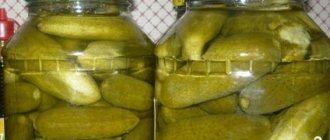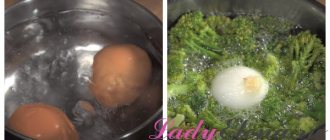How to choose the right squid
It is necessary to select these mollusks based on the appearance of the carcass.
Color of the skin
Skin color is almost never monochromatic. The shade can vary from grayish-pink to purple and even brown.
Squid meat
The meat should be light creamy.
If it is yellow or purple, this indicates that the squid has been defrosted and frozen several times during transportation and storage.
If the color of the meat is white, most likely the squid has been treated with some kind of chemicals.
The meat should be dense and elastic. There should not be a lot of ice and snow in the package.
Purified or not?
It is best to buy unpeeled squid. Then you can be sure that they have not been chemically treated.
If, nevertheless, the choice fell on a purified product, then it is worth taking those that were cut up and frozen directly on the ship. Such squids are cleaned mechanically and are not re-frozen. It is possible that this information can be read on the packaging.
How long should I cook squid so that it is soft and tasty?
Their softness depends on how and how long the squid is cooked. If squid fillet is overcooked, it will turn out very tough and unpleasant to eat, so let’s look at some of the most popular methods of cooking squid, in which it turns out soft and juicy.
How to cook frozen squid?
- Ingredients: frozen squid – 2 pcs, water – 1 l, salt – 0.5 tsp, bay leaf – 1 pc, spices – optional.
- Total preparation time: 11 minutes, cooking time: 1-1.5 minutes.
- Calorie content: 122 calories (per 100 grams of product).
- Cuisine: European. Type of dish: seafood. Number of servings: 2.
You can cook squid without defrosting (the main thing is that they have already been cleaned before doing this). The sequence of cooking frozen squid carcasses is as follows:
- Pour water into a saucepan so that all the squids fit in it and bring to a boil.
- Salt to taste, and if desired, add spices and bay leaf.
- Place the squid carcasses in boiling water and cook for 1-1.5 minutes, then remove the pan from the heat and cover with a lid. In this state, leave the squid to simmer for 10 minutes.
Standard cooking of squid (carcass, squid rings) for salad and other dishes
Take a large saucepan so that it can accommodate all the squid that we will cook, add water and bring to a boil. Thawed and peeled squids are placed in boiling water for 1-2 minutes (the water is first salted and spices are added to taste), after which the pan is removed from the heat, and the squids are left inside in boiling water so that they cool gradually along with the water. We wait for the squid to cool completely in the water.
How to quickly boil squid?
For use in many recipes, you can use express cooking of squid, during which they practically do not decrease in size and remain soft and juicy:
- Boil water in a saucepan and add salt and spices (bay leaf, black pepper, parsley, dill, etc.) to it.
- After the water boils, add the cleaned squid for 30-40 seconds, after which we immediately remove them from the boiling water.
We also watch a video on how to boil squid easily and quickly:
How to cook squid in a slow cooker?
- Pour water into the multicooker.
- Set the “Cooking” mode.
- Add spices and salt to your taste.
- After the water boils, place rings or whole squid carcasses inside.
- We cook them for 1.5-2 minutes, after which we turn off the multicooker, but we do not take out the squids for 3-5 minutes so that they “arrive”.
How to cook squid in a double boiler?
- Pour water into the special section of the steamer.
- We lay out the squid in one layer on a special grid in it.
- Leave the squid to cook for 6-8 minutes under steam.
The golden rule for how long to cook squid
Squid should never be cooked for more than two minutes; the ideal cooking time for squid is one and a half minutes (range 1-2 minutes). If you cook the squid for more than this time, it will be tough, and the carcass itself will decrease in size.
If you accidentally overcooked squid, then read below what to do in this case.
What to do if the squid is overcooked and becomes tough?
Oddly enough, overcooked squids need to be thoroughly boiled additionally so that they are not tough. Place them in boiling water and cook over low heat for 30-60 minutes. After such additional cooking, the squid will become soft, but at the same time it will boil down greatly (reduce in size) and lose its main beneficial properties.
In conclusion to the article, it can be noted that tips on how to properly cook squid so that they are soft, as well as how to quickly peel squid from the film before and after cooking, will definitely come in handy in every home, because many delicious dishes can be prepared from this seafood, At the same time, it cooks and cooks very quickly. Leave your advice and feedback on how long (minutes) to cook the squid so that it is cooked and soft, in the comments to the article and share it on social networks if it was useful to you.
Yulia Sabinova
Chief editor of the site. Cook, technologist, traveler. I love to cook, read interesting articles about cooking and proper nutrition, learn everything new and share the most interesting things with others. I am glad to see you on the pages of the InfoEda website.
Save on social networks:
How to defrost squid correctly
Fresh squids are practically never found in stores. Frozen seafood for sale.
There are several defrosting methods.
- The best option is gradual thawing. To do this, put the squid carcasses in a bag, tie it tightly, put it in a bowl, fill it completely with water and put it in the refrigerator until completely thawed. The process is not fast, but it is the most gentle.
- A faster method is to prepare the squid in the same way, but do not put it in the refrigerator, but leave it on the table at room temperature.
- You don’t have to fill the squid with water, but shake the bag to defrost evenly.
Defrosting squid
How to remove film from squid
The boiled squid skin is tough and inedible, and the meat underneath is compressed. To properly cook a carcass, you need to remove the outer and inner film. In squids it is called the mantle and can be transparent or colored. Methods for cleaning frozen and fresh seafood are practically the same.
From fresh
Freshly caught shellfish are freed from the film in a couple of minutes. Raw meat is easier to process and is considered tastier and more suitable for cooking. There is a life hack on how to quickly clean squid with tentacles using boiling water.
First, the body is subjected to primary processing. You need to cut off the tentacles, throw away the head, gut the carcass and pull out the internal frame. Then place the fresh squid in a colander. Chop large ones until the film is removed.
Then boil water, scald the squid and immediately pour ice water over it. The robe will come off due to a sudden change in temperature; just pull it with your fingers. It is necessary to remove the film from the thicker part of the carcass to the narrow one. The last thing to clean is the fins.
It is even easier to remove the film from the tentacles of fresh squid. It goes away on its own upon first contact with boiling water.
From frozen
Freshly frozen squids are immersed in boiling water before cleaning. Place the seafood in a separate plate and cover with boiling water. It is not recommended to defrost carcasses beforehand and keep them at room temperature for a long time.
When the film begins to detach from the body, scrape it off under running water. Do not keep squid in boiling water for a long time so as not to accidentally cook it. The insides of fresh frozen shellfish are removed after removing the skin.
How to properly clean squid
How to easily peel squid from film
If you leave the skin on the squid carcass, it will give the finished dish a bitter taste, which is quite unpleasant. Therefore, it is worth cleaning the squid. This can be done quite quickly.
Clean the defrosted squid from the film with a knife or just with your hands.
The film not only does not look aesthetically pleasing in the dish, but also does not taste very good.
No heat treatment
The edge of the film is grabbed with a knife and thumb and removed from both sides, carefully pulling and intercepting closer to the pulp.
It is more convenient to remove the film by cutting the mantle, but this is only possible if the squid does not need to be cut into rings later.
How to clean squid without heat treatment
Temperature difference
You need to take a colander and two pans: one with hot water, the other with cold. You can even add ice cubes to cold water.
There is a process based on temperature changes. There should be enough water so that the colander with squid fits completely.
The squid is placed in boiling water for a few seconds and then in ice water. It turns out to be a kind of contrast shower for carcasses. The main thing here is not to overcook them in boiling water, otherwise they will simply cook.
The film is destroyed by boiling water and can be easily wiped off and washed off the carcass. If necessary, you can clean it with a knife.
How to peel fresh squid from film
If you are lucky enough to purchase fresh squid, then you should take maximum care to preserve its taste and still refuse boiling water and ice.
You need to pry the colored and transparent skins together with a knife and carefully separate them from the carcass. With proper patience, efforts will be rewarded. This is similar to the film being peeled away from the liver. It’s still better to pour boiling water over the tentacles.
Mini-cooking cleansing
If in hot summer weather the squids managed to melt on the way from the store to the house, then the question arises of how to properly clean them in this case. Boil water in a saucepan with the addition of spices, salt, bay leaves, etc. as desired.
The squid is cut lengthwise and the insides are removed. Next, rinse with running water and immerse in boiling water. Cook for no more than 3 minutes, then quickly remove. The film usually separates on its own and remains in the water. Here's how to boil and clean squid at the same time.
How to clean already boiled seafood
Sometimes the question arises of how to clean squid from the film if it is already boiled.
You can also boil unpeeled squid. To do this, they are washed with running water, boiled and cooled. After this, the film is removed from the finished squid like a stocking.
Unpeeled squid is usually boiled whole and used in salads.
How to clean tentacles
Squid tentacles are cleaned in the same way as the carcass. Only here the hot method is still preferable.
How to remove entrails from squid
These mollusks are usually sold without the head. To remove the entrails, the carcass must be grabbed by the upper part, holding the body. With the other hand they pull out the insides.
Next, the chord (translucent seal) is removed. It's kind of like a squid's spine. To do this better, turn the squid's mantle inside out and just pull.
How to clean raw squid: step-by-step instructions with video
To peel frozen squid easily and quickly, do not defrost it completely. The skin can be cleaned better if the meat is still slightly frozen. We will describe step by step how to clean a whole squid carcass. If you already have it without a head, just skip some steps. Prepare a small sharp knife and scissors and begin the cleaning procedure:
More recipes on our website: Cooking whole pink salmon in the oven in foil: recipe with step-by-step photos
- Take the clam and carefully separate the head directly with your hands.
- Squeeze out or remove the entrails and chitinous plate.
- Use scissors to trim the tentacles away from the head. Only the tentacles need to be trimmed, as the beak is suitable for preparing delicacies.
- Pour water into a saucepan and place it on the stove if you are boiling squid. For frying, prepare a frying pan with vegetable oil.
- While the water in the pan is boiling, turn on cool water and, using a knife under running water, begin to peel the film off the fillet. First you need to pry it off from the edge of the carcass. The skin will come off in parts. So please be patient. Lightly frozen squid will clean faster.
- After cleaning, rinse the carcass thoroughly inside and out. Inspect it so that no chitinous plate or film remains.
Attention! Using boiling water, cleaning the squid from the film will be faster. However, experts do not recommend using this method, as the meat becomes less tender. But if you are short on time, pour boiling water over the fillet and immediately place it in a container with cold water (after cleaning it from the inside and the chitinous plate). After this procedure, you don’t even need a knife to remove the film.
To make it clearer for you, watch the video on how to properly peel squid from the film:
Basic principles of proper preparation of squid
We have discussed how to clean squid in different variations. It's time to cook.
There are many ways to prepare them: they are boiled, fried in a pan and grilled, served as a main dish, added to pasta, salads and sauces.
The general rule is that squid should not be subjected to long-term heat treatment: the meat will become dry and tough, like rubber.
How to cook squid
To cook squid at home, you can use one of the following methods:
- Prepared carcasses with the film removed should be poured with boiling water for 10 minutes.
- Place the carcasses in boiling salted water and bring to a boil again. Remove from heat and leave covered for 5 minutes. Remove from water and cool.
- Cook the carcasses by lowering them one at a time into strongly boiling salted water for 10 seconds.
You can add spices to the cooking water, such as peppercorns and bay leaves.
You can’t throw a lot of squid into the pan at once: cooking will occur unevenly, some of the seafood will be cooked, and some will remain raw.
How to properly cook squid on the grill
First, the carcasses are marinated in olive oil, adding spices: salt, pepper, rosemary, coriander, thyme. You can marinate squid in sour cream, mayonnaise or kefir - whatever you like.
Then the shellfish needs to be placed on the grill for literally 1-2 minutes. The meat will instantly set and become elastic. Remove from heat, add salt and pepper - the product is ready to eat.
The main thing is not to overcook the squid, otherwise it will become tough, like a rubber sole.
To serve the dish, you can use green oil (thyme, rosemary, garlic and parsley are ground with vegetable oil). You can use a mixture of oils, for example, olive and sunflower. You can also bake lemon with the squid.
grilled squid
How to quickly and easily clean squid at home
You can often find fresh frozen squid on sale, from which many popular dishes are prepared at home (for example, sea salad with squid). In order for the cooked squid meat to be soft and tender, it is better to remove the film from it, which, if you do not know certain tricks, is not so easy to separate from the carcass. Let's consider how you can clean frozen squid carcasses from film, giving them heat treatment and without it, as well as how to properly clean a whole squid, but before that, how many minutes to defrost the squid.
How long does it take to defrost squid?
For many products, including squid, gradual defrosting is desirable, so if you intend to prepare a squid dish, it is better to defrost the squid carcasses in advance by moving them from the freezer to the regular food compartment of the refrigerator or leaving them in a plate with cold water at room temperature.
You can defrost squids in a faster way by placing them in the microwave in the defrosting mode, but if you do not have a microwave oven in your house, then you need to take care of defrosting the squids in advance, using the advice presented above.
Important: you cannot defrost squids by pouring hot water or boiling water over them, so as not to spoil their beneficial and tasteful qualities.
Sequence of cleaning a whole squid
True connoisseurs of seafood will say without hesitation that it is better to buy whole squid, rather than ready-cut carcasses, since in factories, during the cleaning process, whole squid is subjected to mechanical and thermal processing, due to which some of its beneficial properties are lost, and also processed meat will not work cook very tender and tasty. In many supermarkets you cannot always find whole squid, but if you can find them, then pay attention to them, and not to frozen and cleaned shellfish.
Cleaning a whole squid can be divided into several stages, so let’s look at them in more detail:
- Take a whole squid carcass (if it was frozen, you need to defrost it in advance).
- With one hand we take the squid carcass (the part without eyes and tentacles), and with the other we take the squid’s head behind the eyes and smoothly separate the head from the main carcass.
- We clean (squeeze out) the insides from the carcass, and also take out the chitin plate.
- We cut off the tentacles from the head (it is important not to cut off the small beak of the squid, which is quite sharp), which can also be used to prepare delicious dishes.
- Under running water, gently prying it with your nails or a knife, remove the skin (film) from the carcass.
- We thoroughly wash the cleaned squid fillet inside and out.
If you bought frozen squid carcasses that have already been cleaned of tentacles and heads, you will still need to clean them at home from skin and film, as well as from possible remains of entrails. There are several ways to clean squid from the film: by treating them with boiling water and without heat treatment.
How to clean squid from film without heat treatment
According to many squid lovers, this method is the best, because during cleaning the squid is less subjected to heat treatment (unlike the method when it is doused with boiling water for easier cleaning) and its meat remains more tender and soft after cooking.
The process of cleaning squid takes place in the following sequence:
- The first step is to remove the skin from the carcass by prying it with a fingernail or a knife; it is easier to peel off if the squid has not been completely thawed.
- Next, it is important to carefully remove the film from the squid fillet, which is also lifted and pulled off in parts from the carcass.
- Finally, the squid meat is washed well under running cold water (outside and inside), carefully inspecting each carcass so that there are no small film residues left on it. If there are any, it is better to remove them.
As you can see, cleaning a squid carcass is not difficult and it will only take a few minutes. To clearly see how squid are cleaned, you can watch the video below:
How to remove film from squid by scalding it with boiling water
The fastest and easiest way to clean squid carcasses from skin and film is to scald them with boiling water, after which it is much easier to remove the film:
- Prepare cold water and boiling water in advance.
- We take out the chitinous plate inside from the squid.
- In a separate container (deep plate or pan), pour boiling water over the squid carcasses, then immediately transfer them to a container with cold water. Due to rapid temperature changes, the skin will peel off and be removed much easier.
- Remove the film from the squid by hand, after which we wash the cleaned fillet under cold running water.
A more visual example of quickly cleaning squid using heat treatment is the video below:
Cleaning whole frozen carcasses
To clean the squid, you need to defrost it.
The best way to defrost is gradual, gentle.
To do this, the carcass is transferred from the freezer to the refrigerator compartment.
When it thaws, you need to move it to room temperature and keep it until the normal state is completely restored.
Important!
It is unacceptable to defrost this seafood by steaming, in water or placing it close to heating appliances. Such “barbaric” methods irreversibly deteriorate the taste, smell and texture of squid meat.
We clean it in the same way as freshly caught fish. Afterwards, rinse the carcasses with water and place them in boiling water.
The length of stay in boiling water depends on further actions.
If you immerse it in ice water after scalding, there will be 10 seconds of blanching remaining. Carcasses removed from cold water can be easily cleaned by hand. This method is reliable, but squid cleaned using this method is not as tasty.
If the squid will be cleaned immediately after being removed from boiling water, then you need to keep it in the water for about a minute. The film is carefully cleaned with a brush. The meat of squid cleaned using this method is juicier after cooking.











